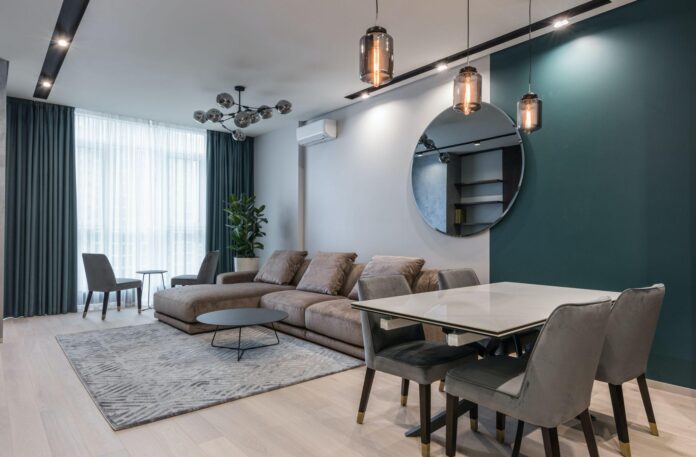
Photo by Max Vakhtbovych from Pexels
Conventional or traditional and contemporary or modern designs are at opposite ends of the design spectrum. Not only do the lines and shapes of modern and traditional spaces differ, but so does the sheer number of stuff in a traditional vs. modern environment. Modern interiors, while not always the case, have a more pared-back, minimalist aesthetic. In contrast, traditional rooms have a more maximalist aesthetic, with more going on visually.
However, opposites attract in design. Combining traditional and modern design sensibility can also result in a lovely, comfortable home. Here is some advice on blending modern and classic furniture items.
Traditional Interior Design
Older Americana designs such as Colonial and Craftsman are frequently referred to as traditional designs. However, as traditional design ideas become more prominent, designers are turning to British design for inspiration.
Dark wood furniture is typical in traditional spaces. Furniture from the Craftsman and Colonial periods has modest adornment, whereas Victorian-era items are more intricate and detailed. Traditional style includes patterned and leather upholstery, wallpapered walls, slipcovered sofas, and finishing touches like wainscotting and crown molding. A blue and white color combination is a classic conventional aesthetic in terms of color palettes. Saturated, earthy colors are popular among individuals who prefer the British take on tradition. Due to its gorgeous patina that gives off an antique vibe, brass is the most typical metal finish you’ll encounter in a classic room.
Traditional design, in general, is a more subdued, less formal style that emphasizes comfort and livability.
Modern Interior Design
People often refer to Mid-Century Modern when they say they prefer a modern look. Natural wood is combined with vibrant colors in this style, which is inspired by mid-century design. Clean lines and organic curves characterize furniture with minimal ornamentation beyond the shape of the object itself. It also has rounded edges and tapering edges without any rough angles.
The colors utilized in these spaces are bold, with primary and secondary colors being the most common. Colors like teal, red, orange, yellow, and green come to mind. In these areas, graphic, geometric motifs are also common. Lighter wood tones are preferred, such as a Scandinavian blonde finish or acorn or teak coloring. A dark walnut finish, on the other hand, isn’t out of the question! Chrome is the most frequent finish for metal, while brass and black metal are often employed in mid-century spaces. Leather, tweed, and vinyl are all common upholstery textiles on furniture.
In general, Mid-Century interiors are relaxing and conducive to conversation.
1. Make your base furniture more modern.
When blending interior design styles, one will always be slightly more dominant than the others. Because of its cleaner lines, modern furniture is easier to employ as a foundation than traditional furniture. Traditional pieces are also more manageable to incorporate as accents because they have more individuality. We went with modern shapes for the sofa, accent chairs, and coffee table in this area. The accent pieces, such as the side table and the rug, are, on the other hand, considerably more traditional. Your space will have a highly dynamic aspect because of the combination of forms. A sleek 3-seater sofa and coffee table offer balance and attention in this space, as does the traditional pedestal side table.
2. Go more traditional with your accents.
Accent items may completely change the feel of a room, pushing it toward a more modern or classic look. When choosing a rug, artwork, or tabletop decor, keep this in mind. Botanical-inspired prints are more traditional in this bedroom, while abstract art is more modern and diverse. You could also go for a more traditional piece of art, lean it against a shelf rather than hanging it on the wall, or put a print in poster hangers rather than a full-frame. In either case, it will give a conventional subject a more modern spin.
A softer, vintage-inspired rug feels more traditional, but a strong geometric rug feels more modern. And, because this type of rug is prevalent in highly traditional and even classic homes, a vivid Turkish or Oriental-style rug is a great way to merge these two styles.
Layering rugs is also a terrific method to give a living room or bedroom a more modern and relaxed feel. Use a neutral woven rug as the foundation and a patterned rectangle rug on top. This will give your room additional dimension and a more modern feel. You may also layer by hiding carpets, providing a more classic area with an organic shape.
3. Choose traditional silhouettes with modern twists.
If you want a more classic look, look for base furniture with traditional silhouettes but a modern touch. Because the finish, not just the shape, dictates the style of a piece of furniture, a modern finish is a fantastic method to achieve this balance.
In a living room, you may use the same strategy with sofas or accent furniture. With contemporary upholstery, a traditional roll-arm sofa can feel updated and current. Likewise, a spindle-leg coffee table with a sleek finish, such as matte black wood, accented with modern accents and objects, will give your set-up a more contemporary feel.
4. Set the tone with color
Warmer, richer color palettes are used in traditional settings, especially those that trend toward the decorated British style. On the other hand, modern color palettes are intrinsically more monochromatic and “cool.” There are two methods to color when merging these two styles, both of which will assist in creating the tone for this blended design.
One option is to use a modern, neutral color palette with historic furniture pieces. This allows the space’s rich wood tones and ornate traditional furniture to speak for itself. However, another approach to combining both styles is using a warm and rich color palette with modern-lined, neutral furnishings. For example, the dark wall is a classic, rich green in the room above. But the white brick and lighter wood tones of the modern bookcases create contrast and establish a more modern aesthetic.
5. Mix materials and finishes.
Another fantastic method to combine traditional and contemporary styles is to mix materials. For example, a chandelier in a room is more traditional, but the minimalist style in a black metal finish lends a modern touch. In addition, a brass mirror, seagrass bench, and hide rug give the space a more eclectic and contemporary air while using traditional materials and finishes. Warm, worn leather is a more conventional material. At the same time, the chair’s clean lines and tapering legs give it a more contemporary feel. Tweed and other textured textiles can be utilized to tie both styles together.
Consider using wood tones as well. While lighter wood tones aren’t typical in mid-century furniture styles, a dark walnut finish is occasionally utilized in these rooms. Walnut is a typical finish in traditional spaces. On the other hand, mixing wood tones is a terrific approach to incorporate the heart of both designs. For a fun material combination, combine darker woods (more traditional) with flashy metals (a whole mid-century modern approach).



